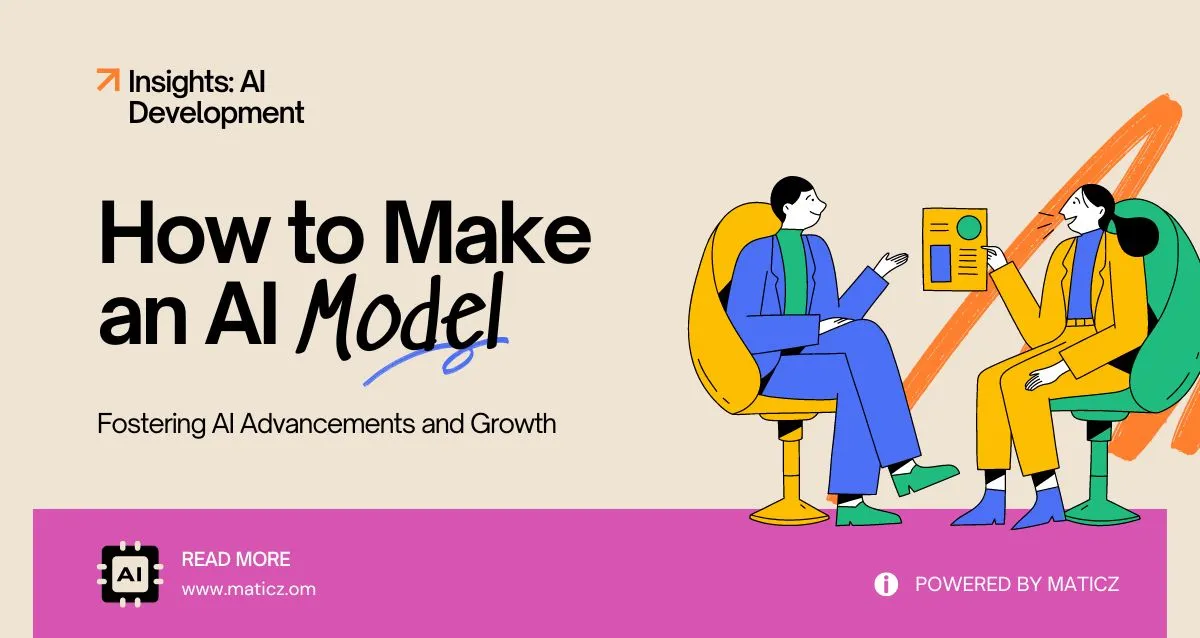Share Posts

How to Make an AI Model: AI Development Guide (2026)
46
4055
103
Introduction
No one would have believed if somebody told us that there would be machines that imitate human intelligence, a few decades before. Building an AI model has become the need of the hour for many businesses to adapt to the demands of today’s digital world.
From healthcare, finance, and supply chain to research analysis, it has set foot in almost every industry and made them realize the importance of AI adoption. Especially the release of ChatGPT has brought a new awakening to the possibilities of what this AI can do.
More and more businesses are realizing the power of Artificial Intelligence in driving growth. Studies show that 84% of C-level executives believe they need to adopt and use AI to meet their growth objectives.
The adoption of this innovative technology has increased like never before few years. We can see AI-enabled devices everywhere we look. Nearly 77% of devices use Artificial Intelligence in some way or another.
As per Statista report, the market for artificial intelligence is expected to witness strong growth in the years to come. Its current value of $100 billion is expected to grow twentyfold by 2030, reaching nearly $2 trillion.
According to Statista, the number of AI-powered digital voice assistant units is expected to surpass the total global population in 2024, with 8.4 billion units expected to be in use.
In this blog, we'll guide you through how to create an AI model step by step. We'll cover what AI models are, their types, the complexities involved in creating them, and some tips for dealing with those complexities successfully. So, stick around and keep reading.
What is an AI Model?
An AI model refers to a computer program that is trained on a large dataset of data to perform specific tasks by recognizing patterns, making predictions, or solving problems. This data can be anything from text and images to audio and video. It is essentially a representation of knowledge and expertise encoded into a system, allowing it to generalize and adapt to new situations.
AI model serves as a tool to simplify complex processes using human-like capabilities to improve the efficiency and accuracy of business operations. AI models can analyze large amounts of data and identify patterns that humans would miss. This can lead to better decision-making in various areas, such as business, finance, healthcare, and government. In essence, AI models are the engines that power the remarkable capabilities of artificial intelligence
Why Build an AI Model?
Artificial Intelligence (AI) models are at the forefront of technological innovation, offering a myriad of benefits and opportunities across various industries. A multitude of reasons drive the decision to build an AI model, each contributing to the transformative impact these models can have on businesses, society, and the way we interact with technology.
Automation and Efficiency
One of the primary reasons for building AI models is to automate repetitive and time-consuming tasks. Especially with Generative and Adaptive AI, AI systems can handle large volumes of data and perform complex computations at speeds that surpass human capabilities. This leads to increased efficiency, allowing organizations to allocate human resources to more strategic and creative endeavors.
Data-Driven Decision-Making
By analyzing patterns and trends, these models empower decision-makers with valuable information. Businesses can make informed, data-driven decisions that enhance strategic planning, optimize operations, and gain a competitive edge in the market.
Predictive Analytics
Building AI models for predictive analytics allows organizations to forecast future trends, behaviors, and outcomes. This is particularly valuable in fields like finance, healthcare, and marketing, where accurate predictions can lead to proactive decision-making and risk mitigation.
Innovation
AI models drive innovation by tackling complex problems and pushing the boundaries of what's possible. In fields like scientific research, drug discovery, and space exploration, AI accelerates the pace of discovery and opens up new avenues for exploration that may have been otherwise impractical.
Cost Savings
Implementing AI models can result in significant cost savings over time. Automation reduces the need for manual labor in certain tasks, and improved efficiency translates to streamlined processes.
Types of AI
Artificial Intelligence can be broken down into three types based on its capability to learn and perform tasks. Let’s take a look at each of them in detail.
Artificial Narrow Intelligence (ANI) Machine Learning
Artificial Narrow Intelligence is also known as narrow AI or weak AI. These AI systems are designed to do specific tasks or commands such as image recognition, language translation, speech recognition, etc.
This type of Artificial Intelligence is pre-programmed to do one task at a time. For example, AI facial recognition is a type of narrow intelligence that can only find and identify human faces. But cannot do anything beyond this. ANI technologies cannot learn itself beyond what is trained and they use machine learning and neural network algorithms to do specific tasks.
Some of the examples of artificial narrow are the intelligence AI models that you have heard about so far such as Alexa, and Siri.
Artificial General Intelligence (AGI) Machine Intelligence
Artificial General Intelligence, otherwise known as AGI can perform all the tasks humans can do. This type of intelligence can learn, think, and perform more than specific actions just like humans.
The main reason behind designing artificial general intelligence is to create machines that are capable of multitasks. Though it cannot match human intelligence and problem-solving skills, data engineers are working on building a strong AI system.
To mention a few examples of general intelligence, generative AI models such as chatGPT, supercomputers, and quantum hardware all come under this type though some of their launches are in progress.
Artificial SuperIntelligence (ASI) Machine Consciousness
Artificial superintelligence, also referred to as ASI is an AI system meant to exceed human intelligence in all possible aspects. This type of intelligence is more of a science fiction than technology.
If ASI is ever to be implemented, then it will be stronger than that of humans. It will act as the foundational technology of fully self-aware AI robots and assistants. When it comes to performing tasks, it exceeds human intelligence and is better at everything it does.
At this point, attaining general intelligence is considered impossible so far, and superintelligence is considered something far beyond our technical capabilities. But still, the next focus once achieving general intelligence will be this.
How to Create an AI Model: A Comprehensive Guide
By following these detailed steps, you can navigate the complex process of creating an AI model, ensuring its success in solving real-world problems and adapting to changing conditions over time.
1. Define the Goals/Problems
The journey to creating a successful AI model begins with a clear definition of your goals or the problems you aim to solve. Whether it's image recognition, natural language processing, or predictive analytics, a well-defined objective sets the stage for the entire process.
2. Collect and Preprocess Data
Begin by collecting relevant and representative data for your problem. Ensure the data is diverse, free from biases, and accurately reflects the real-world scenarios your model will encounter. Preprocess the data by cleaning, handling missing values, and normalizing to create a consistent and high-quality dataset.
Data Collection
Begin by gathering relevant and diverse data that represents the problem or task you want your model to address. Depending on the nature of your project, sources may include databases, APIs, sensor data, or other data repositories.
Data Cleaning
Data cleaning refers to the process of identifying and fixing issues. This step ensures that your model is trained on accurate and reliable information, preventing biases or errors that could compromise its performance.
Data Preprocessing
Preprocessing transforms raw data into a format suitable for training an AI model. This includes normalizing numerical values, handling categorical data, and addressing outliers. Feature scaling, dimensionality reduction, and other preprocessing techniques optimize the data for the learning algorithm, promoting better model performance.
Data Labeling
For supervised learning tasks, where the AI model needs labeled data to learn patterns, labeling is essential. This involves annotating data points with the correct output or category. Depending on your project, you may manually label data, use crowdsourcing, or employ specialized tools for automated labeling.
Data Splitting
To evaluate the performance of your AI model accurately, it's crucial to split your dataset into training, validation, and test sets. The training set is used to train the model, the validation set helps fine-tune parameters and avoid overfitting, and the test set assesses the model's generalization to new, unseen data.
3. Choose Appropriate Tools and Platforms
Selecting the right tools and platforms is a critical decision in the AI model development process. Consider factors such as the complexity of your project, programming languages, and the availability of libraries and frameworks. TensorFlow, PyTorch, scikit-learn, and Keras are popular choices for building AI models. Cloud platforms like AWS, Google Cloud, and Azure offer scalable resources for development and deployment.
4. Select the Right AI Model
Choosing the appropriate AI model is pivotal to the success of your project. Depending on your problem, select a model that aligns with the task at hand. Common models include convolutional neural networks (CNNs) for image processing, recurrent neural networks (RNNs) for sequential data, and decision trees for classification problems. Understand the strengths and weaknesses of different models to make an informed decision.
5. Design For Model Architecture
Define the architecture of your AI model, especially if you're working with neural networks. Specify the number of layers, types of neurons, and the connections between them. Consider factors such as overfitting and underfitting, and design a model architecture that can handle the complexity of your data.
6. Create an Algorithm/Develop an AI Model
With a clear architecture in mind, it's time to create the algorithm or develop the AI model. Write the code that implements the logic of your chosen model, integrating it with the selected framework. Ensure that the model is flexible and scalable for future adjustments.
7. Training the Model or Algorithm
The training phase involves exposing the model to the preprocessed data, allowing it to learn patterns and relationships. Fine-tune parameters, adjust weights, and optimize the training process for improved performance. Validate the model with a separate validation dataset to ensure it generalizes well.
8. Hyperparameter Tuning
Optimize hyperparameters to enhance the model's performance. Experiment with different settings for learning rates, batch sizes, and other hyperparameters to find the optimal configuration. This process involves a balance between underfitting and overfitting to achieve the best results.
9. Evaluate the AI Model
Assess the model's performance using suitable evaluation metrics such as precision, accuracy, and recall. Validate the model against a separate test dataset to ensure it performs well on new, unseen data. Adjust the model if needed based on the evaluation results.
10. AI Model Testing and Deployment
Thoroughly test the AI model in real-world scenarios to validate its reliability and accuracy. Once satisfied with the testing results, deploy the model for use in production environments. Implement monitoring tools to track the model's performance and security measures to protect against potential risks.
11. Ongoing Monitoring and Improvement
The process doesn't end with deployment. Continuously monitor the performance of the deployed AI model. Implement mechanisms to detect concept drift or changes in the data distribution. Regularly update the model based on new data or evolving requirements, ensuring that it remains effective and aligned with its intended purpose.
If you have any idea of creating an AI model and want to know more about the process in detail, hire top AI developers who can help you right from ideation to deployment.
Tips To Create a Successful AI Model
Building a successful AI model involves a combination of strategic decisions, meticulous planning, and continuous refinement. From collecting high-quality data to ensuring model interpretability, each step plays a crucial role in the model's effectiveness and reliability. Here are key tips to guide you through the process.
1. Collect High-Quality Data
The foundation of a successful AI model is laid with high-quality data. Ensure that your dataset is representative, diverse, and free from biases. Invest time in thorough data cleaning, preprocessing, and labeling to eliminate inaccuracies and inconsistencies.
2. Select Relevant Algorithms and Models
The choice of algorithms and models is pivotal in determining the success of your AI project. Different tasks may require different approaches – from simple linear regression to complex deep neural networks. Understand the nature of your problem, and the characteristics of your data, and choose algorithms that align with your objectives. Experiment with multiple models to find the one that performs optimally for your specific task.
3. Regularly Evaluate and Refine Your AI Model
Building an AI model is not a one-time endeavor; it's an ongoing process. Regularly evaluate your model's performance using validation and test datasets. Identify areas for improvement, fine-tune parameters, and adapt to changing data patterns. This iterative approach ensures that your model remains effective in dynamic real-world scenarios.
4. Ensure Model Interpretability
While complex models like deep neural networks may offer exceptional performance, they often lack interpretability. Ensure that your AI model is interpretable, especially in industries where transparency and understanding the decision-making process are critical. Regularly watch out for current AI trends.
Create Your AI Model Now
In the ever-evolving landscape of artificial intelligence, the journey to create a successful AI model is both thrilling and challenging. From the meticulous collection of high-quality data to the strategic selection of algorithms and the ongoing refinement process, we have provided each step with clarity in this blog. Whether you're new to machine learning or an experienced pro, it's important to remember that success in AI is all about understanding, adapting, and improving.
Maticz is a top AI development company known for delivering innovative AI solutions for businesses of all sizes. We offer custom AI solutions and fine-tuned AI models that cater to diverse business requirements. Reach out to us and build an AI-powered future together.
Tap Into the Future
The latest insights, posts, and project updates - straight to your inbox.
.webp)



